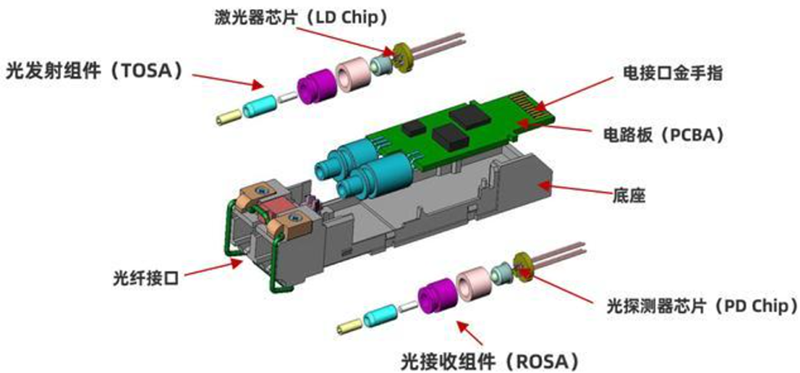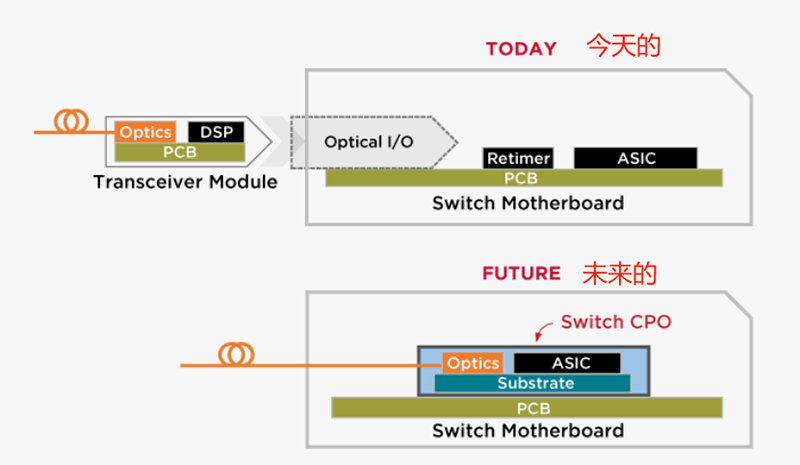Optical module, also known as optical transceiver integrated module, is the core component that realizes the conversion of optical and electrical signals in optical communication systems. It mainly consists of optical devices, functional circuits, and optical interfaces. The transmitting end of the optical module converts electrical signals into optical signals, while the receiving end converts optical signals into electrical signals. The optical module is one of the basic units of communication networks and a key component of infrastructure such as data centers and base stations.

The transmitting end of the optical module converts electrical signals into optical signals, which are transmitted through optical fibers. The receiving end then converts the optical signals into electrical signals and applies them to application scenarios such as telecommunications networks, data centers, and enterprise networks.
According to the transmission rate, optical module products are mainly divided into 200G/400G/800G optical modules, 50G/100G optical modules, 40G optical modules, 25G optical modules, 10G optical modules, and 100M/1G optical modules.
The development of silicon optical technology effectively reduces the cost of optical modules. Silicon optical technology supports high bandwidth deployment by improving data transmission speed and reducing complexity. The use of optical modules produced through silicon optical integration technology in 400G short distance, coherent light and other scenarios can reduce costs. With the gradual development of optical modules in silicon optical technology, silicon optical integration technology has been gradually applied to optical modules in other scenarios such as data centers.
Coherent optical transmission technology supports the development of high-speed optical communication modules. Coherent optical transmission technology is being increasingly used in the field of optical communication, gradually sinking from backbone networks to scenarios such as urban and edge access. In the field of data communication, coherent technology has also become the mainstream solution for interconnecting data centers, and the usage of coherent optical modules is expected to experience rapid growth in the coming years.
The development of Co Package technology is driving the reduction of power consumption in high-speed optical modules. Co Packaged Optics (CPO) is a technology that integrates optoelectronic devices onto a single substrate, aimed at addressing the challenges posed by next-generation bandwidth and power requirements. As the signal rate increases to 1.6Tb/s and higher, the issues with pluggable optical modules gradually become prominent, mainly manifested in high power consumption, high latency, and space occupation. Many people believe that CPO is the development direction of the 1.6T era and beyond.

At present, chips and optical modules are packaged separately to form two independent modules, which are then placed on high-speed PCB boards and designed in a modular manner. The advantage of this is that if any module has a problem, it can be replaced separately. The disadvantages are high power consumption, low integration, large footprint of high-speed PCB boards, and high cost.
In the future, by using CPO, silicon optical modules and chips will be packaged together on semiconductor boards for integrated integration. The cost, power consumption, and size will be greatly improved compared to the current ones, and network bandwidth will also be significantly accelerated. The benefits of CPO are a significant reduction in power consumption per unit of data, outstanding energy efficiency ratio, and improved reliability. The power consumption of the currently pluggable 800G optical module is 14W, and the CPO can reach 5W.
CPO brings together expertise in fiber optics, digital signal processing (DSP), switch ASIC, and packaging and testing, making it a revolutionary technology for data centers and cloud infrastructure. The packaging of CPO involves packaging technologies such as 2.5D/3D, TSV (silicon via), TGV (glass via), etc. The demand for bandwidth in networks and computing structures is accelerating, and there is an urgent need for innovative systems and chip architectures to alleviate the slowdown caused by Moore's Law. At the same time, copper interconnects are rapidly reaching their bandwidth distance limits. Silicon photonics is important for maintaining rapid data growth and supporting high bandwidth applications such as Ethernet switching, artificial intelligence/machine learning (AI/ML), and high-performance computing (HPC).
This article is reprinted from the internet. If there is any infringement, please contact us to delete it. Thank you!


















